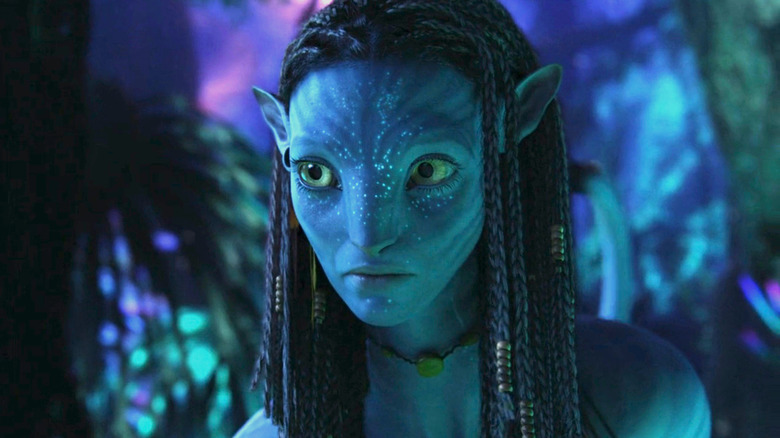What Is Papyrus: How A 'Dishonest' Font And SNL Joke Came To Define Avatar
Six years before he let his Kenergy shine bright in "Barbie," Ryan Gosling brought everything he could to one "Saturday Night Live" sketch in 2017. The sketch in question, titled "Papyrus," focuses on a man named Steven (Gosling), who refuses to let go of his frustration over the use of the famous, oft-derided Papyrus font in the marketing and subtitles for "Avatar."
"It haunts me," Gosling's Steven morosely muses in the sketch's opening narration. "I forgot about it for years, but then I remembered that 'Avatar,' the giant international blockbuster, used the Papyrus font as its logo." Later, when a friend tries to calm him down by insisting that the "Avatar" marketing department must have created their own, altered spin on Papyrus, Steven screams back, "Well, whatever they did, it wasn't enough!" Since its release, the sketch has racked up well over 20 million views on YouTube.
It didn't mark the first time that "Avatar" had been lambasted for its use of Papyrus. On the contrary, the font, which was created by Chris Costello in 1982, has been a go-to target of ridicule for years. It wasn't surprising then when "Avatar" was quickly and repeatedly trashed online for its implementation of the font in the years following its release. The jokes became so frequent and well-known, in fact, that the film's 2022 sequel, "Avatar: The Way of Water," was released with an original font in Papyrus' place — one known as "Toruk."
However, just because the "Avatar" franchise has seemingly moved on from Papyrus doesn't mean that its initial use of it isn't worth investigating. That's particularly true, considering that there are some who have defended the font's use in "Avatar."
James Cameron still likes Avatar's font
As part of an article published by The Ringer, Papyrus creator Chris Costello revealed that it was only after Microsoft and Apple bought the font that it became pervasive. The public availability of the font led to it being overused — pure and simple. "I started seeing it everywhere," Costello explained. When he checked out "Avatar" in 2009, he was, consequently, surprised to see how heavily the film relies on his font. "I thought it seemed like it worked, but others went really deep into the evils of not going the custom route," he added. "It was at a time when Papyrus was overused."
Mostly, the viewers who cared were upset that the "Avatar" team had seemingly spent so much money on making the film's fictional world feel as real and new as possible only to rely on a publicly available, easily recognizable font like Papyrus. Articles were written about the decision. Director James Cameron and his collaborators, meanwhile, were mocked for their apparent love of the font, which had, along with Comic Sans, already become everyone's favorite to make fun of by 2009. The jokes reached their zenith when "Saturday Night Live!" then released "Papyrus" in 2017.
For his part, Cameron claims that he wasn't all that familiar with the font when he chose it to be in "Avatar." Indeed, during an Empire Magazine Q&A conducted in 2022, Costello asked Cameron about the use of Papyrus in "Avatar," to which the director responded, "I was not aware that our font was an off-the-shelf thing; I assumed the art department or the title company came up with it. Of course, it was trolled mercilessly, but frankly, I like the font."
Some fans still defend Avatar's use of Papyrus
Beyond James Cameron's own affection for it, there are some who believe Papyrus is the perfect font for a movie like "Avatar." In his own conversation with The Ringer, David Kadavy, who wrote a small book called "In Defense of Papyrus," noted that the font is, what he calls, "materially dishonest" because it's created to look like it's been etched on parchment paper despite being typed on a digital screen. Kadavy argues that Papyrus' inherent dishonesty mirrors the collective deception of the human characters in "Avatar," who disguise themselves to "look like the Na'vi so that they can infiltrate their culture and take over their land for resources."
This observation, while compelling, may not be enough to sway the film's biggest critics. Cameron, however, seems as unbothered as ever by all the jokes that have been made about "Avatar" and its font of choice. "I guess you know that your movie has made the grade as a cultural icon when people are still stressing over the title font a decade later," he joked in his Empire Q&A.
When Costello asked him whether he chose Papyrus because of how often it's been used to represent Indigenous cultures onscreen, Cameron even offhandedly remarked, "If Papyrus resonates with the issues of Indigenous cultures in the public consciousness, then that fits well with 'Avatar,' so I'm not losing any sleep over it."
It seems, in other words, safe to say that those who have both defended and criticized the use of Papyrus in "Avatar" have thought about it far more than Cameron. That, of course, only makes the uncontrollable obsession of Ryan Gosling's "Papyrus" character even funnier.


